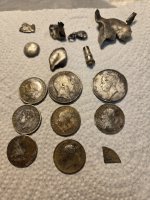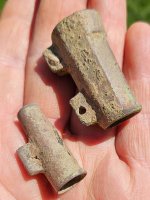I found this jar base while creek walking. I decided to use it for a practice piece for knapping. This will help me to not waste my larger flint pieces while I learn.
I chickened out; decided to stop for awhile, before it breaks. Hopefully it’ll resemble a blade/knife when finished.
I’m having some trouble trying to get the platforms thin enough to take a decent chip while pressure flaking.
The wooden man is 3” tall, for comparison.


I chickened out; decided to stop for awhile, before it breaks. Hopefully it’ll resemble a blade/knife when finished.
I’m having some trouble trying to get the platforms thin enough to take a decent chip while pressure flaking.
The wooden man is 3” tall, for comparison.





